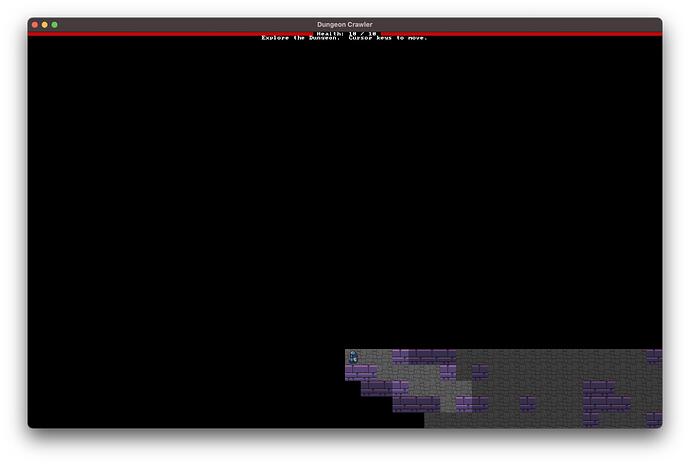About to have to step away, but found this interesting tidbit that may point to rendering issue.
I THINK there’s a bug in field_of_view_set() that doesn’t “see” x == 0 or y==0
In the fov.rs file, after
fov.visible_tiles = Some(field_of_view_set(*pos, fov.radius, map));
I added:
println!("FOV @{:?}={:?}",pos, fov.visible_tiles);
(NOTE: in both cases, I dumped the map to the console to verify there were walls along the top row and left side, and went to a floor tile at y ==1 or x == 1. I would expect their FOV sets to include the walls a x == 0 or y == 0). (Found a map with both, so player is at (1,1)
Map dump:
----------------------
Drunken Map
----------------------
################################################################################
#...####............##....#.#....##.......####.....#.....###..#.....#.##.#######
###....#.#................#......###....#######........#.####..##........#######
#####...........##...............####....######..........####..####...#..#######
#######.##..#...###...###...##...........##......#..#......###..##....#..#######
######..........#...#........#..####.....##..#..........##.#....###..##..#####.#
#######....#......####..#.........###.#...#....##..#....##..#.###..........###.#
#########.##.......####.#.............###...............###....##..#..##..####.#
########........##..##......#...#.....###...##......##..####..####.#..###......#
#########........##..#......#...##....####..#..#..#.##.#####..####..#........###
##########.......###.....#........##..###......####.##.#####..#....##.....##.###
##########...##..####.......##....#.........#######.....####..##.#####....##.###
##########...##..###.........#..###...........##........###....#..#####..##..###
###########..#.....#....##...#..#...#...##....###....#..##....##.######......###
##########...#.##..#..............##....#....####..#....####.##..####.....######
#........##..#.###.....................####..####....####.........####....######
#######..........#........###...##.....####.####...######...###..####....#######
#####....#.....#..........##....##.#....###.#####....####.#####..###..##...#####
####...#####...###...........#...#.......##.###.....#####...###......#####..####
####....###..#.###.......##.##.......##.#...######..######.######...######..####
#####....##.#................#......###.#.########..###....#####..#.######..####
###......##......##......#######...###..#..######...###..######..#....###..#####
############.##..##......#######...###.##..#####..#..#...######....#####..######
###########..##..............##..#........#####..##..##########....#####.#######
###########......#...........###....#.###..########...#########....####..#######
#############...##....###.....#..####...@.###########.#########.#######.########
#############..###....####......########..###########.########...#####....######
##############..#.....#####......#######..########....#########....######...####
##########.............#####....#########....#####..######################...###
##########...##..#.##...######..###########.######..########################.#.#
#########..####.#..#..#..####........####...#####..#########################...#
#######...####.......###...#########.####..######..#########################..##
#######.#####..#..##..####.#########.#####.######..########################....#
#######....##.###..#....##.########..#####..###...##########################...#
##########.##...#....##.....########.######..##.############################...#
##########..###.###.####..#..###############....###########################..###
##########.###..###.###........#############...###########################..####
##########......###.####..##################...###########################A#####
##########.#..#####.####..###################..#################################
##########.#..#####.#####..###################.#################################
##########..#.....#.####...#################...#################################
##########...####.#.##....#################..###################################
###########..###.....####.##############....####################################
##########..####...######..############..#######################################
##########.#####.#########.###########..########################################
##########..####.#########...###################################################
###############..########....###################################################
################....##....######################################################
#################..#############################################################
################################################################################
(Got lucky with a top-right corner that demonstrates both)
Field of view for:
log (reformatted for readability)
FOV @Point { x: 1, y: 1 }=Some(
{Point { x: 1, y: 1 },
Point { x: 6, y: 3 },
Point { x: 3, y: 2 },
Point { x: 5, y: 3 },
Point { x: 4, y: 1 },
Point { x: 2, y: 2 },
Point { x: 3, y: 1 },
Point { x: 8, y: 4 },
Point { x: 4, y: 2 },
Point { x: 8, y: 3 },
Point { x: 5, y: 2 },
Point { x: 6, y: 2 },
Point { x: 7, y: 3 },
Point { x: 2, y: 1 },
Point { x: 1, y: 2 },
Point { x: 7, y: 4 },
Point { x: 4, y: 3 },
Point { x: 7, y: 2 }
})
 (you
(you 


 I’ll go over this thread today and turn it into action items. I’m going to have to strike a balance between the focus of the book (teaching Rust/gamedev) and making the procgen content a bit more solid. I’ll get back to you soon with some ideas - thanks for taking the time to look at it all.
I’ll go over this thread today and turn it into action items. I’m going to have to strike a balance between the focus of the book (teaching Rust/gamedev) and making the procgen content a bit more solid. I’ll get back to you soon with some ideas - thanks for taking the time to look at it all. )
) ). If that’s the case, you might want to make sure you’ve bumped to 1.5 on the master branch.
). If that’s the case, you might want to make sure you’ve bumped to 1.5 on the master branch.